Star Trek: Discovery is back for a new season, and tonight’s premiere episode “Brother” brings with it a new captain, a new mystery, and some crisp writing which offers a welcome respite from the relentless stress of the Klingon War and the Mirror Universe.
At its core, “Brother” is an episode about family, whether it be one at home, aboard ship, or the family we carry with us in our memories. We meet the new interim captain of the USS Discovery; we see another chapter from the life of young, orphaned Michael Burnham as she joins her new Vulcan family; we see a Starfleet engineer struggle to survive as she works tirelessly to keep her crewmates alive; we watch as Paul Stamets (Anthony Rapp) struggles to live without his partner Hugh Culber (Wilson Cruz).
Through flashbacks to their childhood introduction to one another, we see that the tension between Burnham and Spock has been present from day one. While the young, apprehensive Burnham (Arista Arhin, returning from “The Vulcan Hello”) seems quietly interested in her new sibling, Spock (newcomer Liam Hughes) shows clear resentment toward Burnham and the immediate connection her humanity gives her with Spock’s human mother, Amanda (Mia Kirshner).
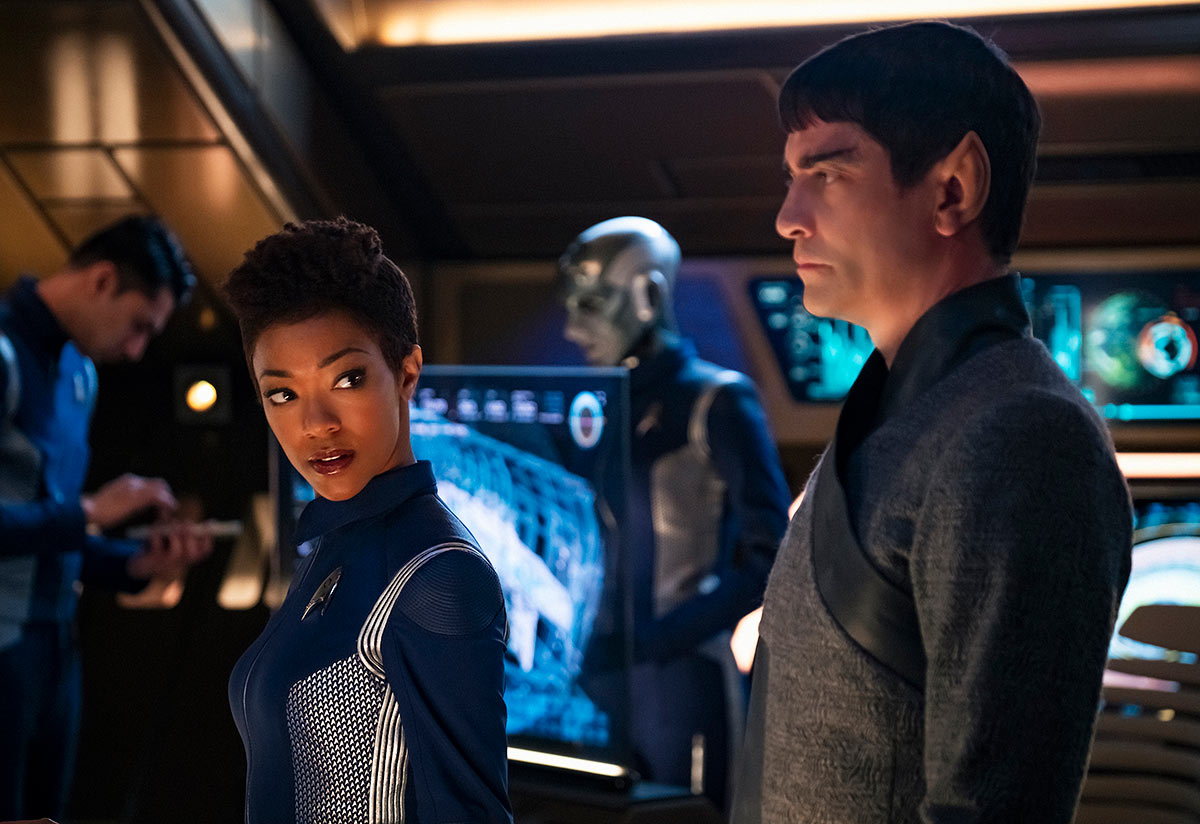
In the intervening years, something dramatic clearly happened that drove Spock away from Burnham and Sarek (James Frain), but the nature of their schism is unknown. It’s interesting to see how Sarek, who is still aboard Discovery as the ship is interrupted on its journey to Vulcan, seems not only to understand but also to appreciate the life his human daughter has made for herself.
Comparing the Sarek of “Brother” to the one we see in “Journey to Babel” in the Original Series (and the following films), it seems that Sarek’s coldness with his son may have much more to do with Spock himself — and not Spock’s humanity.
Even with the character-heavy focus of “Brother,” there’s still plenty of action. Captain Pike’s (Anson Mount) mission aboard Discovery is to track down a mysterious energy signal that appeared, along with six others, at the exact same time in different parts of the galaxy. The other six signals have disappeared, but the seventh “red burst” remains. Once at the signal’s coordinates, however, Discovery finds not an energy source but a gravitationally-anomalous asteroid with the wreckage of the USS Hiawatha embedded in its surface.
Burnham and Pike, along with engineer Nhan (Rachel Ancheril) and science officer Evan Connelly (Sean Connolly Affleck), two of Pike’s crewmates from the Enterprise, undertake a mission to investigate the downed ship. To get there, Burnham comes up with a plan that involves flying a squadron of experimental pods through the debris field surrounding the asteroid.
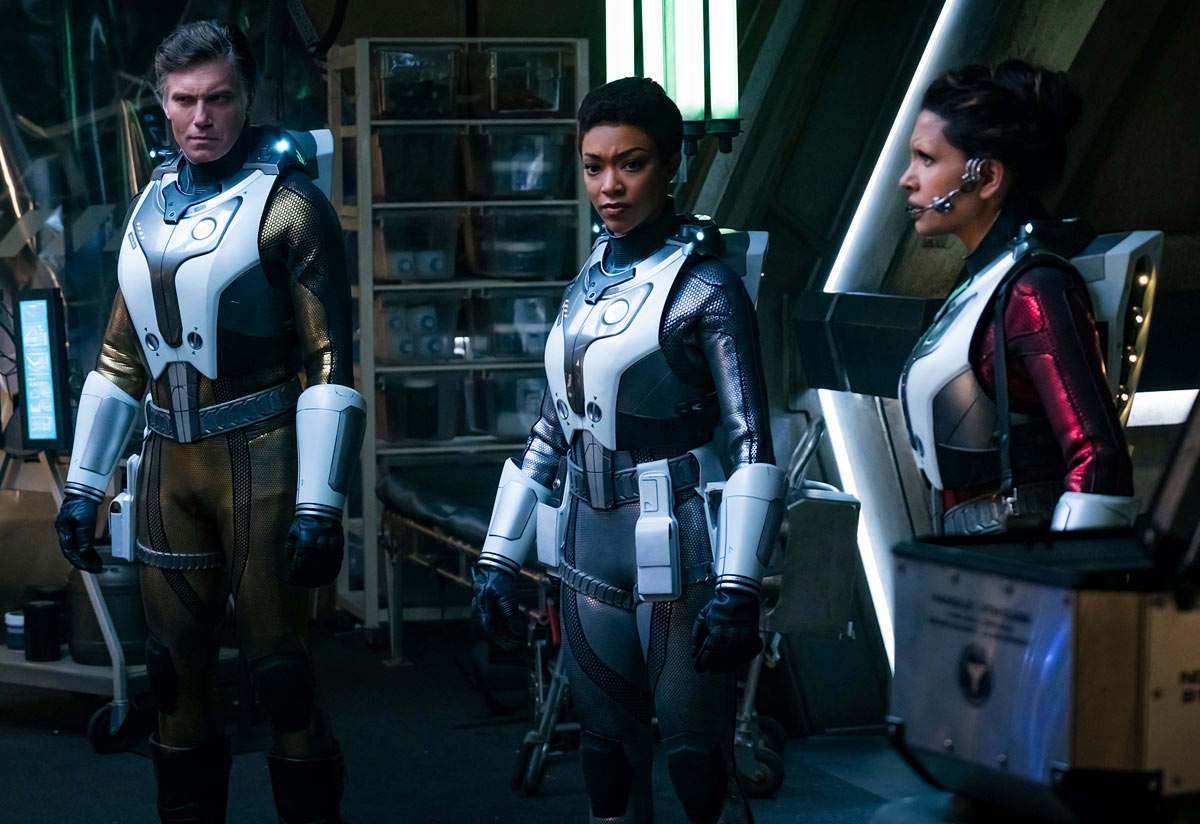
While the sequence looks good, and is technically well-executed — and the reveal of their location below Discovery’s shuttle bay was a nice surprise — I was completely taken out of the action by the sudden and highly convenient presence of the pods on Discovery’s equipment manifest, as well as that while they seem extremely difficult to fly, no one receives even a moment of training prior to being shot into space.
In an otherwise cleanly-written episode, the whole pod sequence comes across as a bit sloppy — but those new color-coded space suits are some great new wardrobe work from Star Trek: Discovery’s costume designer Gersha Phillips.
Apparently some flight training would have been useful, as only three of the four members of the landing party make it to the asteroid’s surface. Let us take a moment to mourn the rare blue-shirt loss of Evan Connelly. (We hardly knew ye, but honestly, that’s okay because you were a bit of a dick.)
In the wreckage of the Hiawatha, the team comes across Commander Jet Reno (Tig Notaro), an engineer who has single-handedly managed to keep several severely injured crewmates alive despite the terrible shipboard conditions — and despite the face that she’s not a medical doctor. As I said in my spoiler-free review, Tig Notaro’s performance makes Reno immediately feel like a three-dimensional person, and she brings a spark to the role that is vibrant and compelling. I truly hope we haven’t seen the last of Reno.
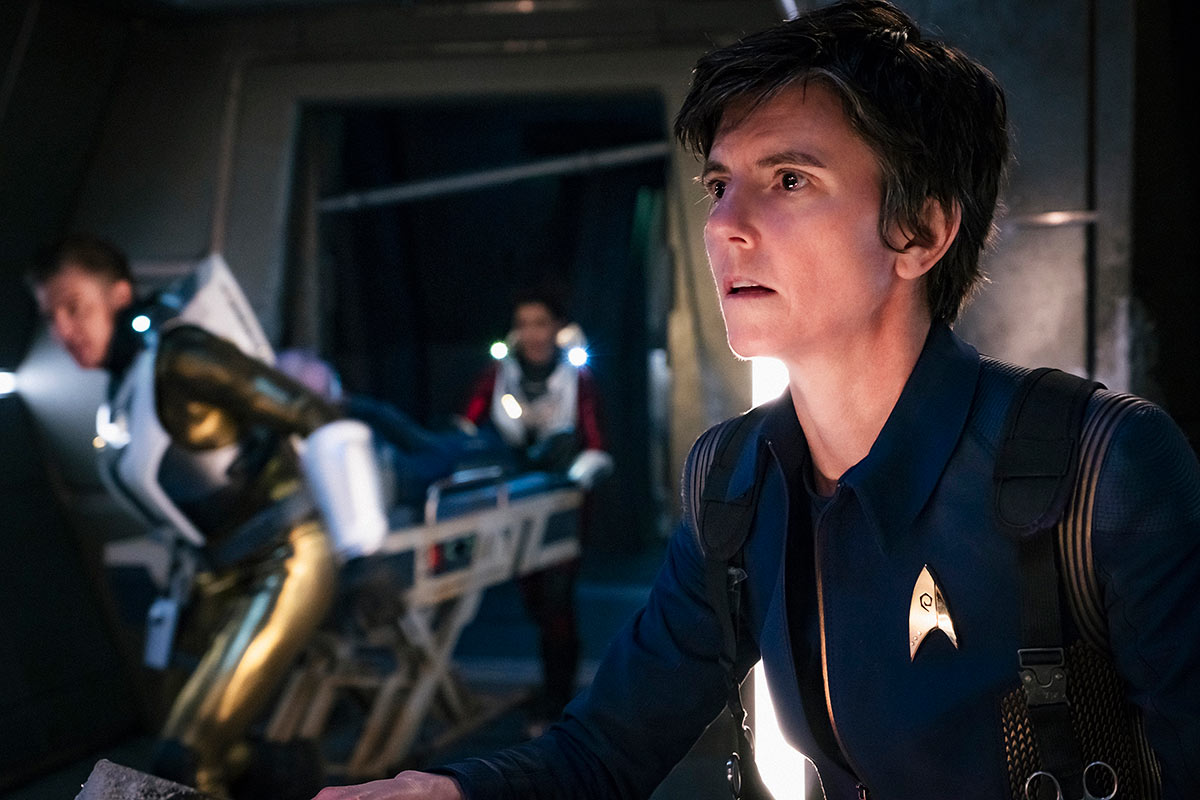
After executing a tricky artificial-gravity maneuver to quite literally scoop up a chunk of the unusual asteroid debris, Discovery warps back to meet up with the down-for-repairs Enterprise. Though Spock isn’t aboard, Burnham decides she needs to visit his quarters in an attempt to understand and possibly even help him.
We don’t see much more of the Enterprise’s interior than what has already been revealed in the Season 2 trailers — “Brother” only gives us a peek at Spock’s quarters and the entryway beyond his door, both of which follow the now-familiar Starfleet architecture of this series. The appearance of the Enterprise is a topic of much debate, but personally I am neither surprised nor disappointed that what little we see of her interior looks much more like Discovery than the 1966 Enterprise.
Star Trek as a franchise has a long history of updating ship interiors to reflect improvements in technology and budget, as well as redressing existing sets for use as other vessels; Discovery is simply continuing that tradition. However, I understand that this is a sensitive topic and one that is matter of opinion and preference. My opinion is that what we’ve seen so far is fine; your opinion may differ.
I appreciate the use of red accents on the wall panels in the corridor outside Spock’s quarters; the red is a nice nod to the much more colorful ship of the 1960s, without losing Discovery’s existing aesthetic for Starfleet ships. Spock’s quarters are a similar compromise between their appearance in 1967’s “Amok Time” and the officer’s quarters aboard Discovery. I was thrilled when the door to Spock’s quarters made the trademark swoosh as it opened and closed, and the collection of Vulcan knick-knacks inside is a nice touch.
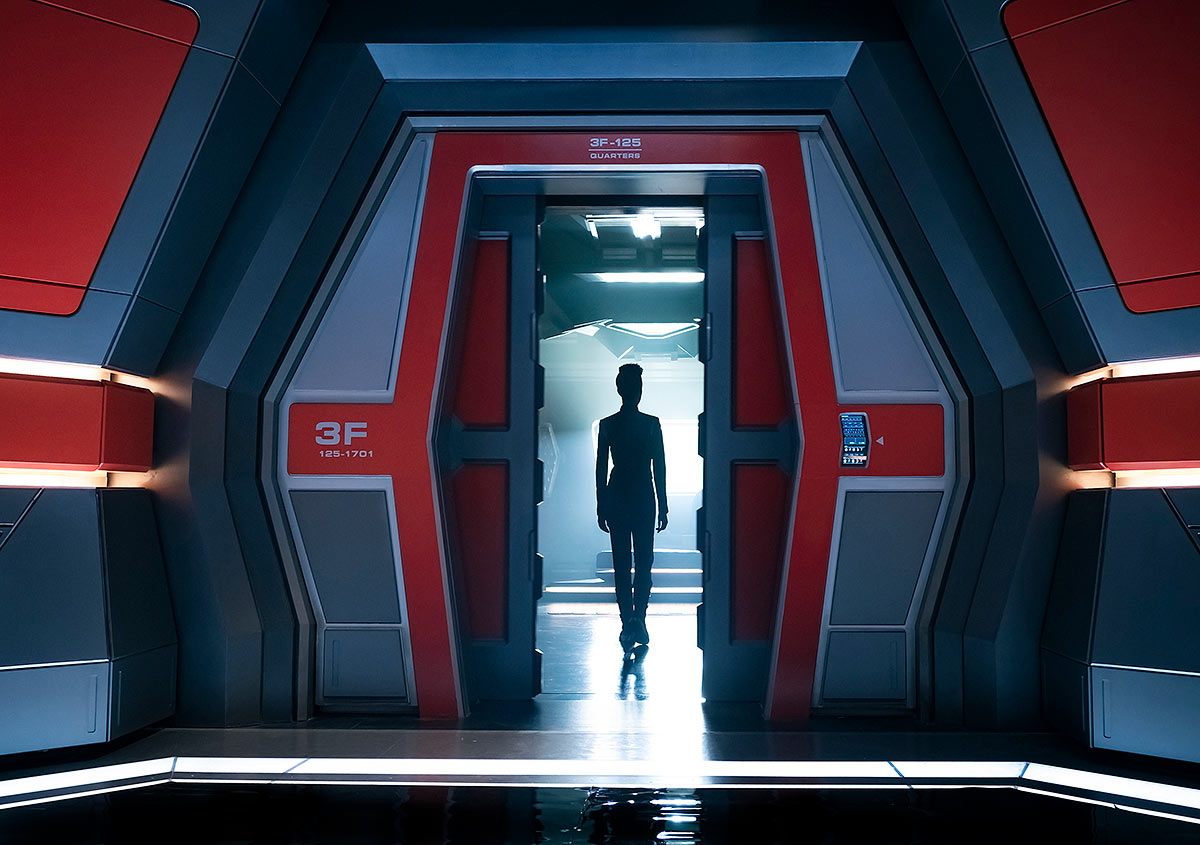
In the closing moments of “Brothers,” we realize — along with Burnham — that Spock’s mysterious absence is connected in some way to the signals that Discovery is now investigating. A personal log recording (featuring voiceover work from new Spock actor Ethan Peck) indicates that he struggled with nightmares as a child, and that they’ve now returned. Working on a hunch, Burnham is shocked to find that embedded in each of his logs is location data that corresponds with the detected signals.
As I mentioned in the spoiler-free review, I’m very pleased with the tone that “Brother” sets for Discovery’s second season. It’s an episode that, despite setting up a story of quite literally galactic proportions, feels character driven and intimate. After last year’s twist-heavy storyline I was hoping for a bit more subtlety and nuance in the new season, and so far I like what I’ve seen — and I’m looking forward to what L’Rell (Mary Chieffo), Tyler (Shazad Latif), and Georgiou (Michelle Yeoh) are up to whenever we finally see them.
Finally, if you’ll allow me a moment to perseverate over a minor detail for a moment, I need to talk about some peculiar design choices in that opening ‘newsreel’ sequence of Saturn footage.

Cassini was a real mission that launched in 1997 and ceased operations around Saturn in 2017. Because of this, showing Cassini images as an old-fashioned newsreel — and pairing them with a NASA logo that went out of use in the early 1960s — struck me as rather strange. Maybe it was just a stylistic choice meant to reinforce to the viewer in 2019 that we’ve been exploring space for a significant chunk of modern history, but if so, I still find myself wondering about the choice of the Cassini mission itself.
Why not choose the Voyager missions, which already have a place in Star Trek lore, or the space shuttles Discovery or Enterprise, which too have existing connections? Unfounded speculation isn’t something I tend to indulge in, but the choice of Cassini — combined with the anachronistic art style — seems too specific not to eventually have some plot significance.
(Also, Cassini was a joint NASA/ESA mission, so I’m sure someone at the European Space Agency is wondering why one of their old logos isn’t also in that scratchy newsreel footage!)
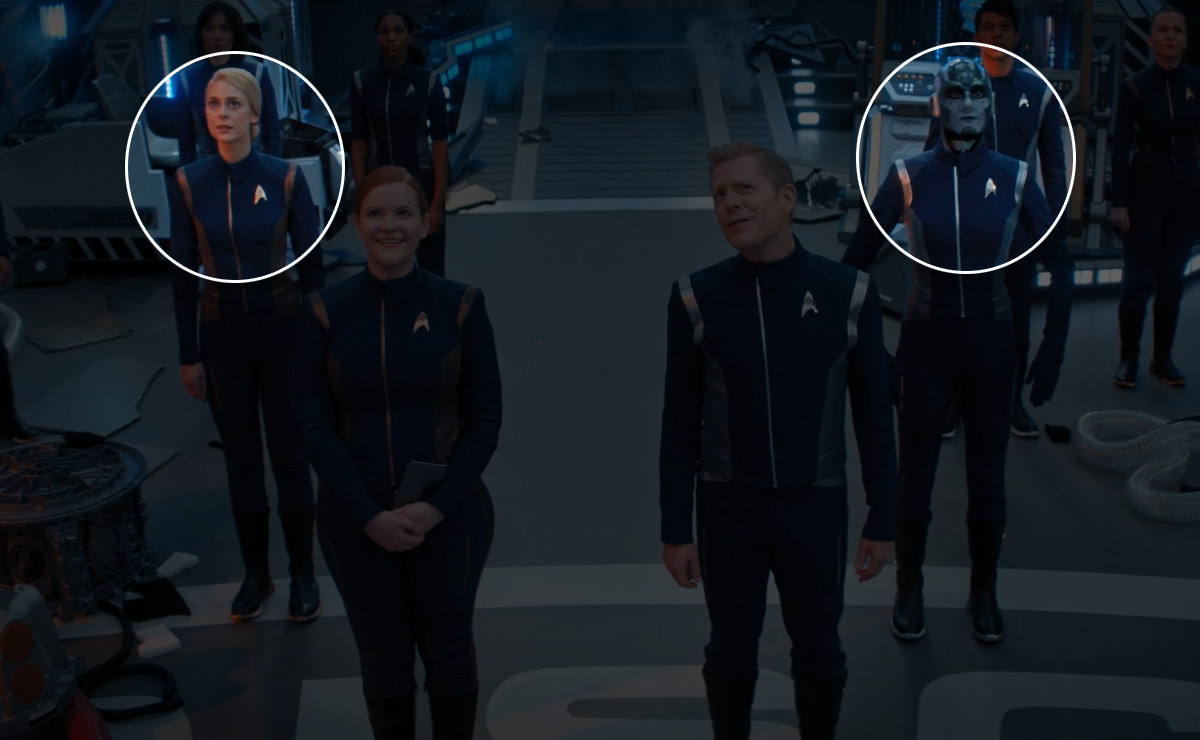
Finally, I’ve got a few other stray observations on “Brother” before I wrap up:
- The complicated prosthetics of bridge officer Lt. Commander Airiam, portrayed by actor Sara Mitich last season, have been reassigned to new actor Hannah Cheesman — while Mitich has been shifted into the role of seemingly-human officer Lt. Nillson, seen behind Tilly during the asteroid-capture sequence. The story doesn’t address the change, so it’s likely to be for behind-the-scenes reasons; we’re looking into it to see if we can find out the reasoning for the robotic reassignment.
- How do Vulcans age, I wonder? Even though last year’s “Lethe” made it clear Burnham was the older child, I wasn’t expecting the childhood version of Spock to be quite so young. Perhaps it’s like the Ba’ku of Star Trek: Insurrection, where they mature to adulthood before their genes put the brakes on the aging process?

- Just before poor, dumb Lt. Connelly was smashed to bits, he had time to mention that his Starfleet Academy roommate was part Caitian, the first live-action name-drop for the cat-like species. The most well-known Caitian in Trek history is, of course, Lt. M’Ress from The Animated Series, though Catians appeared in both Star Trek IV: The Voyage Home and Star Trek Into Darkness as well.
- The brief video message from Hugh Culber we see in the early part of the episode is Wilson Cruz’s first Discovery appearance since last season’s “Vaulting Ambition,” where he said goodbye to Stamets inside the mycelial network. Cruz is a fully-fledged regular this season, as denoted by his inclusion in the newly-revamped opening credits sequence.
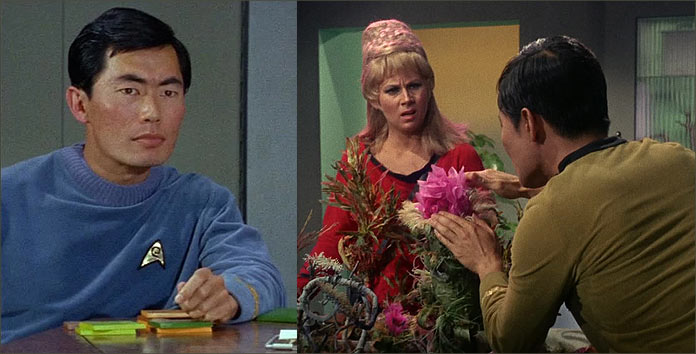
- Finally, Stamets refers to a pal aboard the Enterprise — “a former collegue who is an ethno-botanist aboard that ship” — who can be none other than Hikaru Sulu, who was a Starfleet sciences blue-shirt during this era, and was later seen showing off his love of alien plant life back in “The Man Trap.”
![]()
We’ll be back with our take on Discovery’s second episode of the season next week — in the meantime, what did you think of “Brother” as a start to the new year of stories? Sound off in the comments below!
